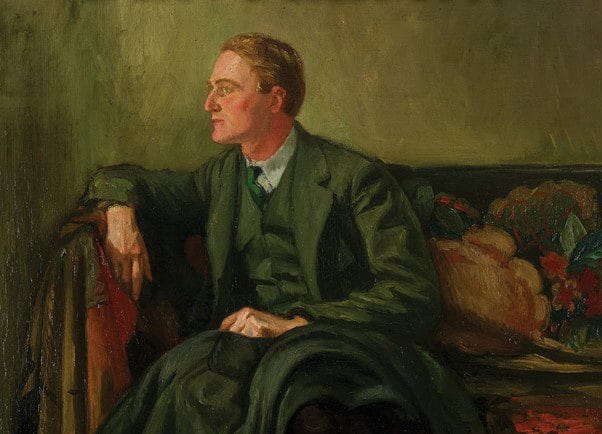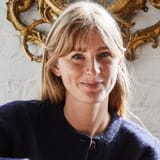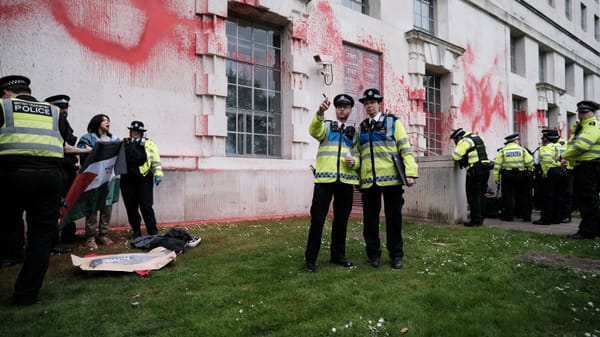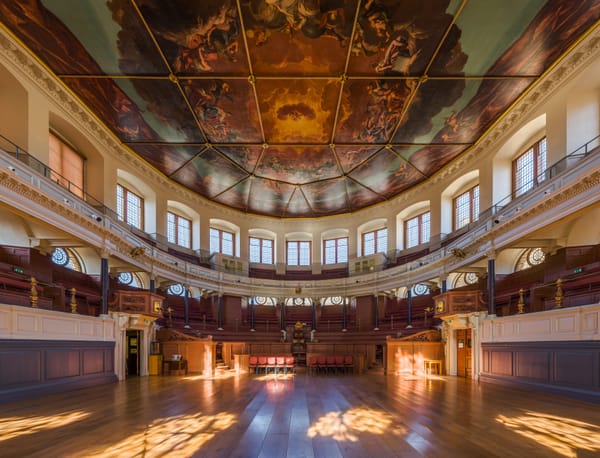Alien encounters
Meet the last Anglo-Jewish gentleman.

Recent visitors to London’s Jewish Museum may have spotted a new portrait on the main staircase, of one of Anglo-Jewry’s most intriguing characters. The pathologist, natural scientist and gardener Redcliffe Salaman (born 1874) and his family were pillars of the early 20th-century British Jewish community. Redcliffe’s portrait, by fellow Anglo-Jew William Rothenstein, was unknown to art historians until now. It was discovered under a bed, badly damaged, by members of the Salaman family while assisting the American historian Todd Endelman with his recent biography of Redcliffe, The Last Anglo-Jewish Gentleman.
Some readers may know Redcliffe as the author of the 1949 monograph The History and Social Influence of the Potato, a pioneering work of social history and genetics still in print today. Perhaps fewer will recognise Rothenstein, despite the esteem in which he was held in late 19th-century Britain.
It is not immediately clear what, in choosing Rothenstein to paint him, Salaman might have been trying to tell the viewer about his Jewish identity. (Another portrait of Salaman exists, painted by his sister-in-law, the actress Chattie Baldwin Salaman née Wake. It features the Salaman coat of arms in the upper left-hand corner, itself crowned with a menorah). While Salaman had definite ideas about what made one a Jew, a subject he and his wife Nina discussed often, Rothenstein had a more complicated relationship with his Jewishness.
Both men were born into affluent Jewish families. Redcliffe was named after the Chelsea square in which he grew up, his family having traded ostrich feathers for property speculation, and east for west London. Rothenstein was one of three sons of textile trader Moritz Rothenstein, who emigrated from Hanover to Bradford in his early twenties. The young Will was raised by his observant mother Bertha, however, with whom he attended the recently-established Bradford Reform synagogue as a child. Meanwhile, his father converted to Christianity, joining the German-speaking Unitarians in Will’s early childhood. Rothenstein’s relationship with religion was rather confused as a result: having been baptised on the beach at Scarborough as a child, he was so petrified that Christ would smite him for having a bar mitzvah that when he emerged from the ceremony intact, his disillusionment led him to lose all faith entirely.
While his eldest brother Charles was expected to follow in Moritz’s footsteps as a wool trader, Will had no such obligations, and at 16 was helped by a friend of his father’s, the Bradford-based artist Ernest Sichel, to study in London at the Slade School of Fine Art. There he came under the sway of the Dijon-born painter and sculptor Alphonse Legros, who taught his pupil to admire the early Italian “Primitive” paintings (the Victorian term for Early Italian painting) of Giotto, Mantegna and Masaccio, opening the eyes of a self-confessed “raw, provincial lad, ignorant and ill-disciplined […] to many aspects of dichtung [poetry] and wahrheit [truth].”
Rothenstein’s search for truth compelled the young artist to venture beyond the Slade, with its rigorous, repetitive exercises in copying from classical motifs. Like many of his Bloomsbury friends, he began volunteering in the East End, which was then home to some of London’s poorest inhabitants. Many universities including Rothenstein’s own encouraged their students to dedicate themselves to educating and “civilising” the poor in their free time, and so Rothenstein found himself visiting the People’s Palace in Mile End, Toynbee Hall in Aldgate, and a boy’s club in Leman Street, where he taught weekly drawing classes. At the weekends he could often be found at the Whitechapel Art Gallery, where he acted as a gallery guard during its popular loan exhibitions. In his memoir Men and Memories he described these “worker adventures” in quasi-evangelical terms: “[T]he East End was a part of London remote and of ill-repute, which needed missionaries […] and it flattered my self-esteem to be one of these.” While he often visited Whitechapel, Rothenstein did not feel much affinity with the Jews he met there. How then did the weekly communal newspaper The Jewish World describe him only a decade later as “the painter of Jewish pictures par excellence”?
It was the non-Jewish society painter John Singer Sargent who first suggested that Rothenstein try painting other Jews, whom he remarked had proven “at once the most interesting models and the most reliable patrons”. In this case, Sargent was recommending that Rothenstein approach wealthy Anglo-Jewish families like the Cohens and the Wertheimers, from whom Sargent had been commissioned to paint several large group portraits in the 1890s. (Unlike Sargent, Rothenstein didn’t court patrons, but instead relied on friends and family for commissions). However, Rothenstein’s first encounter with Jewish subjects came about by chance in 1900, when a friend – one of the six brothers of fellow artist Solomon J Solomon – suggested they visit Spitalfields synagogue. Rothenstein describes the encounter in his memoir:
Here were subjects Rembrandt would have painted – had indeed, painted – the like of which I never would have thought to have seen in London. I was very much excited; why had no one told me of this wonderful place?
But to draw in a synagogue, I was told, was out of the question, was against the Law. The Jews here, I saw, were suspicious of strangers; they had lately come from the ghettos of Russia and Galicia, and were fanatically strict; so strict that they rejected the authority of the Chief Rabbi who, in their eyes, was unorthodox. I was suspected, since I was ignorant alike of Hebrew and of ceremonial, of being a missionary from a society for the conversion of the Jews […]. Determined not to waste a subject so precious, I took a room close by in Spital Square, where at last I persuaded 3 or 4 men to sit. Here I worked for two years, painting eight pictures in all. […] I haunted the Jewish quarter, where one observes astonishing types of men and women […] It was the time of the Russian pogroms, and my heart went out to these men of a despised race, from which I too had sprung, though regarded as a stranger among them.

The artist was able to persuade a few of these “strangers” to pose for him, not in their place of worship but in his studio, and this interaction resulted in eight oil paintings, which are now in collections as far-flung as Canada, as well as several nearer Rothenstein’s birthplace, including the city art galleries of Bradford and Manchester. His Jewish models occasionally appear in multiple paintings, as is the case of the red-haired man on the far left of both Carrying the Law and Reading the Book of Esther, suggesting that he developed some relationship with these men.
Despite his self-confessed ignorance of Jewish customs, Rothenstein’s Whitechapel portraits were seen by his contemporaries as masterpieces. One of the eight-part series ended up in Australia, as a gift of the British government, while another made its way onto the “nation’s mantlepiece”, the National Gallery in Trafalgar Square. This painting, Jews Mourning in a Synagogue, was first shown in 1906 at the Whitechapel Art Gallery’s “Jewish Art and Artists” exhibition, an act of communal defiance against the Aliens Act. After the exhibition, members of the Bradford community chose to buy Rothenstein’s work, which was then presented as a gift to the National Gallery of British Art (now Tate Britain) in London. The event prompted the satirist Max Beerbohm to produce a caricature, called “A Quiet Morning at the Tate Gallery”, depicting the curator of the gallery explaining the Jewish ritual to an elderly Jewish trustee, Sir Alfred de Rothschild, who greets the painting with apparent bemusement.

Though Rothenstein expressed that he felt no affiliation with “the greasy […] East End Jews” who modelled for his most celebrated works, his name nonetheless became briefly synonymous with Jewish art in Britain. In 1921, the London Illustrated News ran a double-page feature on “The Jew in Public Life”, in which 16 men “of [that] despised race […] from which I too had sprung” were chosen to demonstrate Jews’ contributions to various professions; Rothenstein was the sole representative of the world of art.
Back at the Jewish Museum, Redcliffe now hangs beside his wife, the Hebrew scholar Nina. In the portrait of her, Solomon J Solomon meets the gaze of his subject, who is interrupted reading a pile of manuscripts, perhaps her beloved Hebrew poetry. (Solomon, a member of the Royal Academy, was an observant Jew). Unlike his wife, Redcliffe appears uncomfortable under scrutiny. Rothenstein has depicted him in profile, his head tilted loftily to balance a pair of delicate gold pince-nez, his mouth tightly pursed. Perhaps the commission was a way of marking his arrival in rural Hertfordshire, where he lived the life of a country squire and could pursue his interest in genetic engineering from his own bucolic surroundings. His gaze wanders beyond the edge of the frame; he is impatient to return to his tubers. The painting strikes me as a compromise on both men’s parts, which tells the truth both of his sitter’s discomfort and of the artist’s own, not entirely at home with being a Jewish painter despite being widely celebrated as one.▼
Isobel Muir is a doctoral candidate at the National Gallery in London and Durham University, where she investigates Jewish constituents of the National Gallery between 1824 and 1945.





